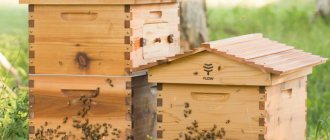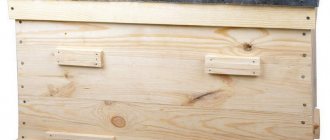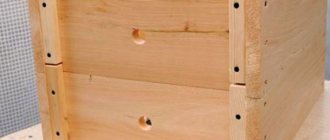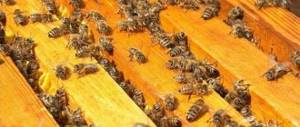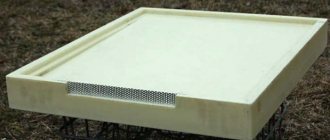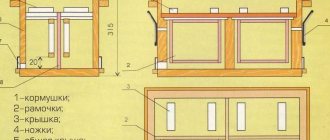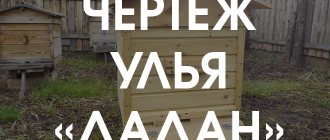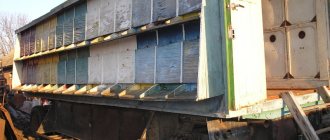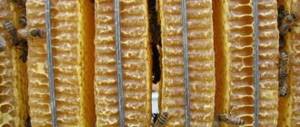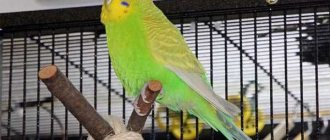The bottom of the hive is the fundamental element of the bee house. In terms of importance, it can be compared to the foundation of a multi-story building. The high bottom of the hive using German technology is now in great demand among beekeepers. As practice shows, the service life of a traditional bottom is approximately 10 years, and a deep pan - more than 30 years. Below are drawings of a high bottom for a hive, as well as its advantages and disadvantages.
Design Features
German technology sets fairly loose frames for the depth of the structure. This indicator can be set in the range of 145-405 mm. Beekeepers, based on the characteristics of the hives, set their own value within the range. First of all, the size of the nests and the size of the bee house itself are taken into account. The advantage of the deep bottom of German hives is that the beekeeper has the ability to adjust the distance to the frames. This is very important, especially in the cold season. With the beginning of the honey collection season, the distance from the bottom to the frames can be increased to make the hive more spacious.
Using German technology, deep bottoms are made of styrofoam, which is characterized by increased moisture resistance.
Blueprints
There are a large number of varieties of deep bottoms of evidence, but they are given one task - to make the bee house stable and ensure its tightness.
Almost all bottom drawings have one feature - a small gap is provided between the bottom and the walls of the hive. This is one of the main requirements for the design of hives. The size of this gap should not exceed 3 mm. What is this gap for? There are two reasons:
- Wet wood swells, and if not for the gap, this factor could negatively affect the ventilation of the hive.
- The gap helps prevent rupture of the walls due to rotting of the boards.
If you do not follow the recommendations, the bee house may simply fall apart due to excessive humidity. This is especially true in the autumn and winter.
The layout of the bottom directly depends on the size of the bee house itself. As for the size of the hive, there is a single standard that provides for a lot of variations.
Is it necessary to install a door on the bottom of the hive?
Some drawings of the bottoms of bee houses have a door. There is a lot of debate among beekeepers about its relevance, so we decided to present the main features and disadvantages of this element.
Let's start with the strengths:
- the presence of a door opens access to the lower part of the hive, where you can put water and fertilizer;
- in the spring, through the door it is possible to inspect the bee family;
- in hot weather, the door can be removed and a mesh installed instead to improve the ventilation of the hive.
Now let's talk about the disadvantages:
- for the wintering period, the door must be dismantled and a tight damper installed instead;
- By removing the frame with feeding, you can harm the insects.
Russian beekeepers actively use a bottom with a door and do not take the disadvantages of such a design seriously.
Pros and cons of a double mesh bottom for a multi-body hive
The double high mesh bottom is a hive part assembled in a special way using German technology, which has its own quite significant and numerous advantages, and some disadvantages. Before choosing a high bottom for your hive, it would be a good idea to become familiar with the first and second ones. First, let's look at the advantages of a mesh bottom:
- good air circulation throughout the year, insects are not in danger of suffocation, and with it swarming, and cold, leading to increased honey consumption and sometimes mortality;
- it is easy and simple to close the bottom of the hive tightly, for example, if there is a threat of pesticides when cultivating fields;
- it is possible to work with smoke without opening the top cover, thereby disturbing the family;
- honey and other products do not become moldy in the spring, and fermentation processes do not occur in them;
- after treating the hive, the pests fall out through the removable mesh, and they are no longer able to return;
- It’s easier to keep the hive clean; the dead stuff collects on the mesh.
Keep in mind! There is no need to purchase a ready-made mesh bottom for the hive; with minimal skills, you can make it yourself.
There are few negative points:
- the price of the product and materials for its manufacture;
- Debris, pollen and wax particles fall on the mesh bottom, which attract moths. So this structure needs to be cleaned and treated with antiseptics more often;
- As winter approaches, brood no longer appears in nests with such a bottom.
Note! In the spring, bees in a hive with a high bottom begin to raise young animals later than usual. Do not be alarmed by this fact - by the time the honey is collected, the family will be strong enough.
What function does it perform?
The most serious and responsible tasks are assigned to the bottom of the hive, as well as to the foundation of a residential building:
- ensuring sustainability;
- maintaining the microclimate in the hive;
- protects the interior space and products from mold and dampness.
The design helps remove water vapor and bring in fresh air, maintaining the desired temperature in the house. Bees are capable of generating enough heat on their own; the beekeeper’s task is to maintain the desired regime. Warmth is not only beneficial for insects, but also saves food.
Fungus and moisture accumulate over time in any bottom, regardless of its type. Thanks to the height of the German design, the mold formed during the winter does not come into close contact with insects, honey and beebread; it accumulates below.
If necessary, the mesh is closed using valves and the temperature inside rises. Such thermoregulation is necessary at the end of winter, with the appearance of brood.
Keep in mind! The double mesh bottom for the hive has proven itself to be excellent in southern latitudes, where the threat of suffocation is more real than hypothermia.
How to keep bees in a hive with a mesh bottom
In the southern regions of Russia, bees can be kept in a multi-hull hive with a mesh bottom all year round. The ceilings of the home are solid, or with ventilation slots, at the discretion of the beekeeper. The main condition is good gas exchange in the absence of drafts.
The cases are mounted on a stand similar to a magazine with a hinged back wall. To give additional strength, the bottom is reinforced with a pair of stiffening ribs. A frame with a mesh is placed on top of them.
For the winter, a housing is placed under the nest as protection from the wind. In case of significant cold weather, the mesh is covered with dry moss.
The dead wood is not removed until spring; it does not interfere with the bees and does not affect the quality of the products. During periods of cold and frost, the entrances are closed until the end of winter.
In March, the empty housing is removed and the mesh is covered with a valve. With the arrival of full heat, the mesh is opened, all sanitary and hygienic procedures are performed through the bottom, without touching the roof.
How to make a mesh bottom for a hive with your own hands
For beekeepers who are interested in the German life hack and want to make it themselves, we recommend a simple guide to making a multifunctional hive bottom:
The best material is stainless steel. It is too tough for rodents and pests, but it is harmless for bees.
Below we attach a drawing according to which the product is assembled. The dimensions given are for the traditional horned model, with a base of 540x424 mm. For houses of other dimensions, the element is made according to a similar scheme, based on the size of the body. The beekeeper chooses the height at his own discretion, usually this figure is in the range of 145-300 mm.
To work you will need:
- a wooden frame equal in size to the bottom of the hive;
- fine mesh mesh;
- frame or 4 bars that will fix the mesh;
- a sheet of plywood, similar in shape to the mesh, but with sides 2 cm smaller;
- screwdriver, self-tapping screws, metal corners.
Note! Smaller mesh sizes provide better ventilation.
Assembly is carried out in this way:
- All wooden elements are boiled in paraffin or wax.
- The mesh is mounted on a frame, fixed with bars or another frame.
- The assembled part is tightened with self-tapping screws.
- At the bottom of the bottom, on the sides, the corners are screwed in; this is the damper element.
Advantages
Among the predominant advantages of a high bottom for a hive, we note the following points:
- Bee houses with a high bottom are considered more protected from moisture and mold, because all this nasty stuff is concentrated in their lower part and does not get close to insects.
- Often, when beekeepers did not provide the bee colony with foundation in the spring, insects begin to build drone combs directed downwards. The presence of a high bottom allows the beekeeper to easily remove parasites and cut out excess honeycombs.
- Cool air, which concentrates in the lower part of the hive, allows you to set the optimal temperature in hot weather.
- The deep bottom makes it possible to significantly expand the nesting space.
- The high bottom opens up various possibilities for the beekeeper when preparing hives for wintering. Bee houses of this design allow you to place supplies of food, water and create an air cushion.
- Beekeepers can provide the bee colony with water or solid food at the desired time.
- The presence of a high bottom allows you to check the effectiveness of pest control. For example, a beekeeper can lay a sheet of paper with a greasy coating on the bottom and analyze the number of killed mites that will accumulate on it.
- Hives of this design make it possible to detect in time the tendency of a bee family to swarm and prevent this process.
- The deep bottom makes the process of thermoregulation easier for the beekeeper. In hot weather, it is possible to set the mesh to the lower position and open the inlets.
- With the help of a high bottom you can carry a bee family. To do this, insects are collected at the bottom of the hive and covered with a “lid” on top.
Hive Dadan - design
Nowadays, the Dadanovsky hive is represented by several types of structures. The main differences are volume, material and thermal insulation.
Hive Dadan
The dimensions of the structure are a strategic issue. It is important to understand what is needed in specific conditions.
- 10 frame. Classic Dadan scheme.
- 12 frame. The square section allows the frames to be positioned differently (with warm or cold drift).
- 14 and 16 frame. It's harder to work alone. An increased number of frames creates a greater load on the structure.
Material
High-quality material will last longer and will not warp or rot. Do not use materials with a strong odor.
- Boards. Wood without knots and rot is suitable. Insufficiently dried wood will dry out over time and cracks will appear.
- Plywood and fiberboard. Cheaper, easier to process, but less durable.
- Polyurethane foam. Light, warm, durable, do not allow sounds to pass through.
- Expanded polystyrene. Lightweight, warm, do not allow sound to pass through and are less reliable.
Insulation
Depending on the temperature conditions, choose one of the types:
- Double wall. The walls are double; insulation (sawdust, moss, straw, polystyrene foam) is placed in the gap between the walls. Keeps you warm in unpredictable spring weather. Recommended in the middle and northern latitudes of Russia.
- Single wall. A lightweight option not designed for low temperatures.
What does it consist of?
Regardless of the dimensions and other features, the Dadan-Blatt hive consists of the following elements:
- Frame. Must correspond exactly to the drawing and have no distortions. All other parts of the structure are attached to it. The entrance is located in the hive body.
- Bottom. Usually made removable. The non-removable bottom is more airtight and rigid, but makes it more difficult to work with bees.
- Extension (store). Installed during the period of active honey collection. Using special techniques, the queen is not allowed to lay eggs in the store. In principle, 2 extensions mounted on top of each other can serve as a second body.
- Liner. Needed for ventilation and insulation of the hive.
- Roof. Most susceptible to weather influences. The roof is painted in 2-3 layers or sheathed with tin. Roofs can be single-pitched, gable and flat.
- Minor design details (tapholes, folds).
Flaws
Well, where would there be without shortcomings? The disadvantages of a deep bottom for hives include:
- The bottom depth indicator can be set in a very wide range and this often plays a cruel joke on novice beekeepers.
- Only experienced beekeepers who have been involved in beekeeping for a long time can use this type of design.
- A deep bottom does not solve the problem with drones, and in some cases even worsens it.
Structural elements and their features
Most often, the hive has a modular structure - it consists of several detachable parts. This is convenient as it allows you to increase the volume as needed. Each of these parts is manufactured separately and the manufacturing precision must be high - all parts must be interchangeable.
Dadanovsky hive of two buildings placed one on top of the other
Frame
This is the central part of the hive, which usually houses the bees' nest. Depending on the number of bodies, hives can be single-body, double-body or multi-body (3 or more). The corps are mentored as the family grows.
Hive body for 12 frames
Roof
The roof of the hive can be single-pitched (sloping backwards) or gable. In any case, it should have overhangs - protrude beyond the geometric dimensions of the hive and protect the walls from exposure to bad weather.
Roof structures for hives
The roof consists of a roof liner - a flat body for placing insulation or feeders for feeding bees - and the roof planks themselves, nailed to the roof liner or screwed with self-tapping screws. The height of the underframe depends on the thickness of the insulation, and this value depends on the region. Typically the height of the roof liner is 80-140 mm. Ventilation holes are often also made in the roof liner to remove moist air from the hive.
Roof liner design
When making a roof, the boards are laid either in two layers with the seams overlapping, or from thicker boards in one layer, but the seams are necessarily covered with thin planks. Roofing iron, roofing felt or roofing felt can be laid on top of the wooden roof of the hive.
When making the roof, make sure that it fits tightly, without gaps. To seal the joint around the perimeter of the body, you can stuff a felt strip or nail a plinth to the outside of the body to cover the joint.
Bottom
The bottom of the hive can be nailed to the body (solid) or can be pulled out or pulled out, i.e. be detachable. The removable bottom makes hive maintenance easier - it allows you to clean the bottom without disassembling the entire hive. Structurally, the bottom can be:
- cold - from a single board;
- warm - made of two layers with insulating backfill.
The bottom can also be double-sided - with protrusions of different heights on both sides, which allows you to adjust the internal volume. Knock it down tightly, without gaps, connect the boards into a quarter or into a groove with additional gluing of the joint with moisture-resistant wood glue. The cracks must be carefully sealed (with wood putty), as wax crumbs are poured into them, and then wax moths appear. Therefore, from time to time they prefer to replace the bottom by knocking together a new one.
Advantages of German technology
Most beekeepers in Russia successfully use the new product, as they positively characterize the innovation and are satisfied with the quality. They note the following positive aspects of the German novelty:
- Moisture accumulates in the lower part of the deep bottom and mold starts growing, since it is the coolest place in the bee house. But unlike the usual bottom, in the new Western-made product this place is located a little further from the winter club of buzzing families.
- The cold air circulating in the lower part of the tray becomes significantly softer, so the climate inside the hive improves. At the bottom of the tray, the nesting space expands and a whole club of a bee family can hang there without any problems.
- A deep tray is a kind of indicator and helps to determine the moment when the swarming instinct appears in pets. Finding out about this is quite simple: just open the door of the house located on the back side. To prevent insects from starting to build up in the deep tray, equip the hive with a net.
- Thanks to the depth of the bottom in the hive, produced using German technology, the temperature regime can easily change, which contributes to excellent ventilation. This is especially good in the summer. For this purpose, a frame with a mesh is installed in the lower part, and the inlet holes are completely open.
- If it is necessary to catch the family for transfer to another place, then a high tray will help cope with this task. It is enough to cover the pallet with something from the top.
- The deep bottom rear door allows you to monitor the situation in the hive at any time of the year.
Beekeepers successfully use the new product
- The effect of treating a bee's home against mites increases. To do this, the owner of the apiary places a sheet of paper on the bottom, on which a greasy coating is applied. In this case, the paper is a kind of indicator, showing how well the processing is carried out. It is also possible to calculate the number of dead ticks over a separate period of time;
- When swarming instinct occurs, the high bottom of the hive is an excellent indicator. In order to see that a bee family wants to swarm, the beekeeper just needs to open the back door;
- You can put a net if the owner does not want the bees to build up the void in the high bottom below;
- A deep tray in the hive provides a quick and at the same time easy change in temperature and improves ventilation, especially in summer. To do this, beekeepers place the frame with the mesh in the lower position and open two entrance holes;
- The high bottom can also be used to catch a bee family and take it to the right place. To do this, you just need to cover it with something on top;
- It will give you the opportunity to quickly inspect the condition of the hive in cold weather or in summer - you just need to open the back door of the deep bottom.
During preparation for winter, two buildings and a deep bottom can provide excellent conditions for wintering bees. The existing three spaces are provided with everything necessary: food supplies, an air cushion, and a winter club. At any time, the beekeeper can add any type of food to his pets. It should be remembered that food is placed when a dense bottom appears on the lower level, which should be accessible to the bees.
Beekeepers are forced to constantly fight against ticks. If during the spring growth period the frames were not treated with foundation, then the bees build drone combs, gradually moving downwards. These honeycombs, along with the mites, can be safely cut off, then the reserves of wax produced by the bees increase.
To treat ticks, a regular paper sheet soaked in some greasy substance is laid on the bottom of the tray. Paper is a kind of indicator of the quality of processing. Additionally, you can count the destroyed pests.
Organic beekeeping
Frame hives for bees
The technology for making frame bee houses has not undergone any changes in a hundred years. As before, only the front and back walls of the hive are insulated. This option is perfect for the Urals, Siberia and more northern regions of Russia. The voids between the inner and outer walls are filled with natural insulation, such as moss or sawdust.
Note! Before you make a hive with your own hands, you need to correctly calculate the thickness of its walls. After all, the air temperature inside the “room” will depend on this parameter.
Cheap polystyrene foam is also often used as insulation. Its advantages are obvious: it holds heat well, rodents do not like it, and it is very lightweight, which greatly simplifies assembly.
